change wheel CHEVROLET S10 1997 2.G Owners Manual
[x] Cancel search | Manufacturer: CHEVROLET, Model Year: 1997, Model line: S10, Model: CHEVROLET S10 1997 2.GPages: 402, PDF Size: 21.04 MB
Page 69 of 402
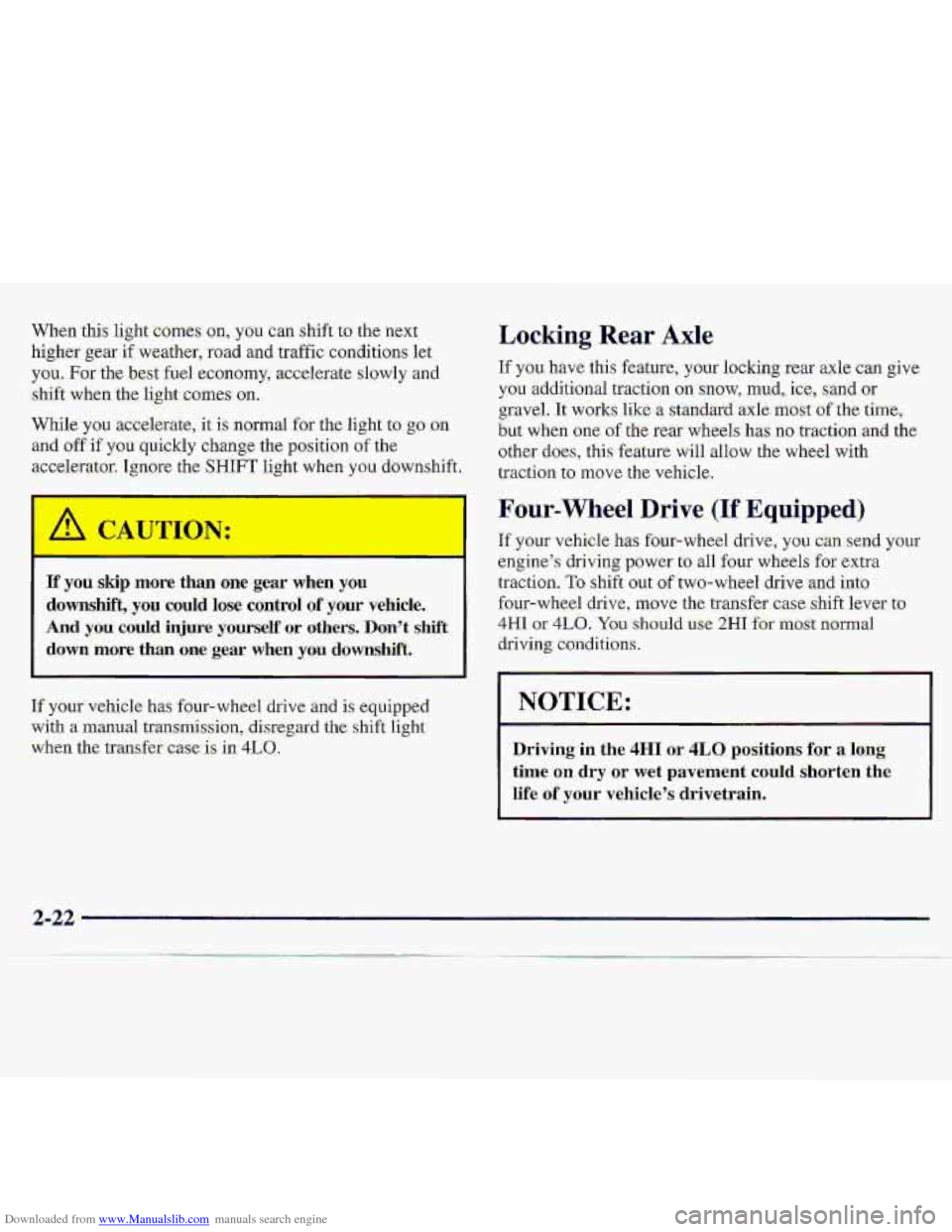
Downloaded from www.Manualslib.com manuals search engine When this light CoLmries on, you can shift to the next
higher
gear if weather;-road and, :traffic conditions let
you. Fa; the best fuel economy, accelerate slowly and
-:shift when the light..come,s on..
-Whil.e you accelerate, it is normal for the bght to go ,on
and off -if you quickly change the pwition of the
accelerator. Ignore
the-SHIFT .light when you downshift.
I
If you. skip more I in one gear when you
downshift, you could lose control of your vehicle.
;And y.ou could injure yourself or others. Don't shift
down more than om gear when you downshift.
If your vehicle has four-wheel drive and is equipped
with a
~znanual transmissim, disregard the shift light
when the- transfer
case is in 4LO.
Locking Rear Axle
If you. have this feature, your 1acking.rear axle- can give
you additional tracfim ~n snow, mud," ice, sand or
gravel. It. works like a standard axlemost ofthe the,
but when one
of the rear wheels- has no tractimand the
other
does, this €eatwe will allow the wheel with
traction to move .the vehicle.
Four-wheel Drive (If Equipped)
If your vehicle has. four-wheel drive, you-can send your
engine's dwi.ving power to all four wheels for extra
traction.
To shift QUt of tw-o-wheel drive and into
four-wheel drive, move the transfer case shift lever to
4HI or 4LO. You should use, 2HI-fix.xnost normal
driving conditions.
NOTICE:
~~~~ ~~~ ~~
Driving in the 4HI or 4L.O pusitions for a Icing.
time 0.n dry or wet pavement .could shorten the
life of. your vehicle's drivetrain.
2-22
Page 84 of 402
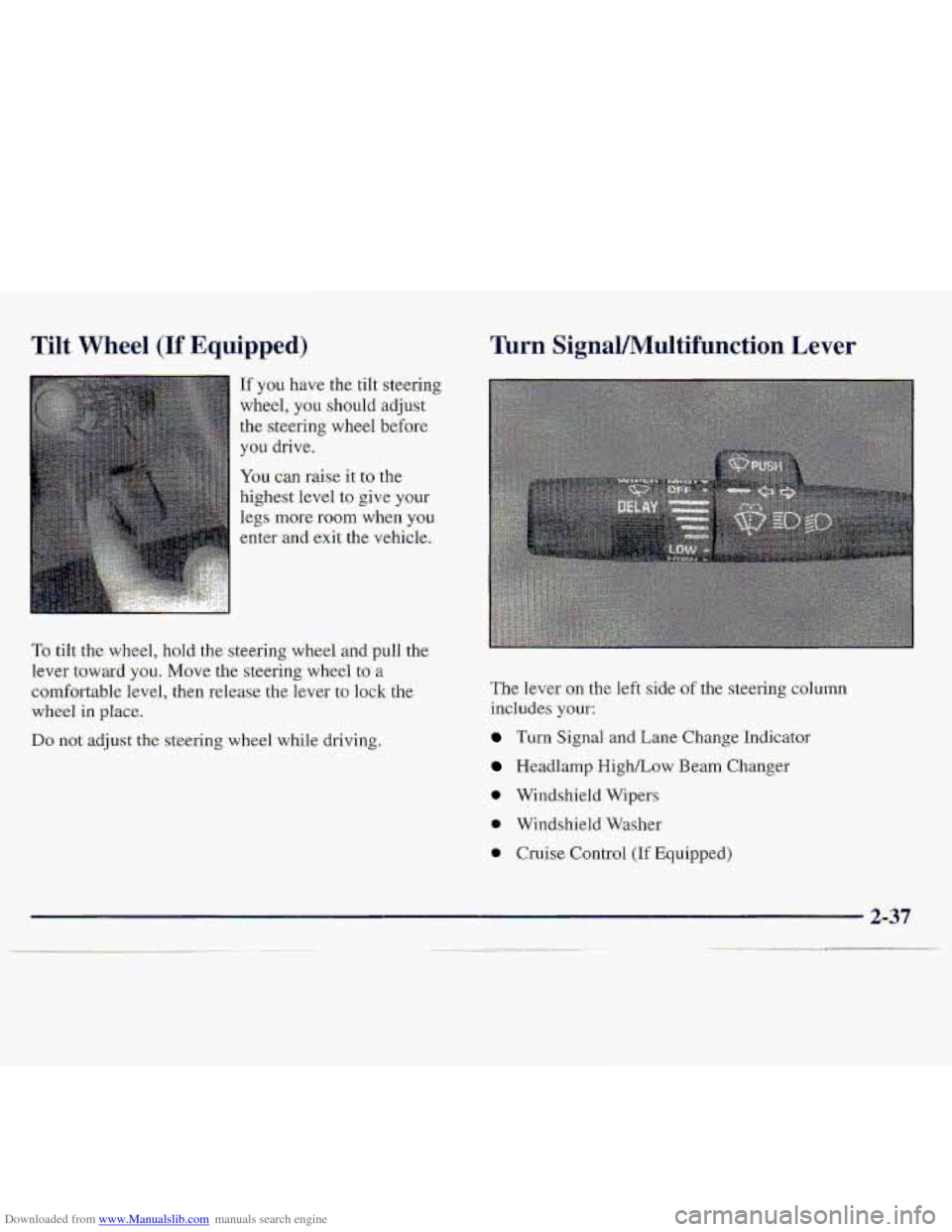
Downloaded from www.Manualslib.com manuals search engine Tilt Wheel (If Equipp-ed)
If you have the tilt steering
wheel, you
shou1.d adjust
the steering wheel before
you drive.
You can raise it. to the
highest level to give your
legs
more room when you
enter ,and exit the vehicle.
To tilt the. wheel, hold the steering wheel and puli the
lever
toward you, Move the steering wheel to a
comfortable level, then release the lever to lock the
wheel in place..
Do not adjust the steering wheel while driving,
Turn Sig-nal/Multifunction Lever
The lever on the left side of the steering column
-includes your:
Turn Signal and Lane Change Indicator
Headlamp High/Low Beam Changer
0 Windshield Wipers
0 Windshield Washer
0 Cruise Control (If Equipped)
Page 87 of 402
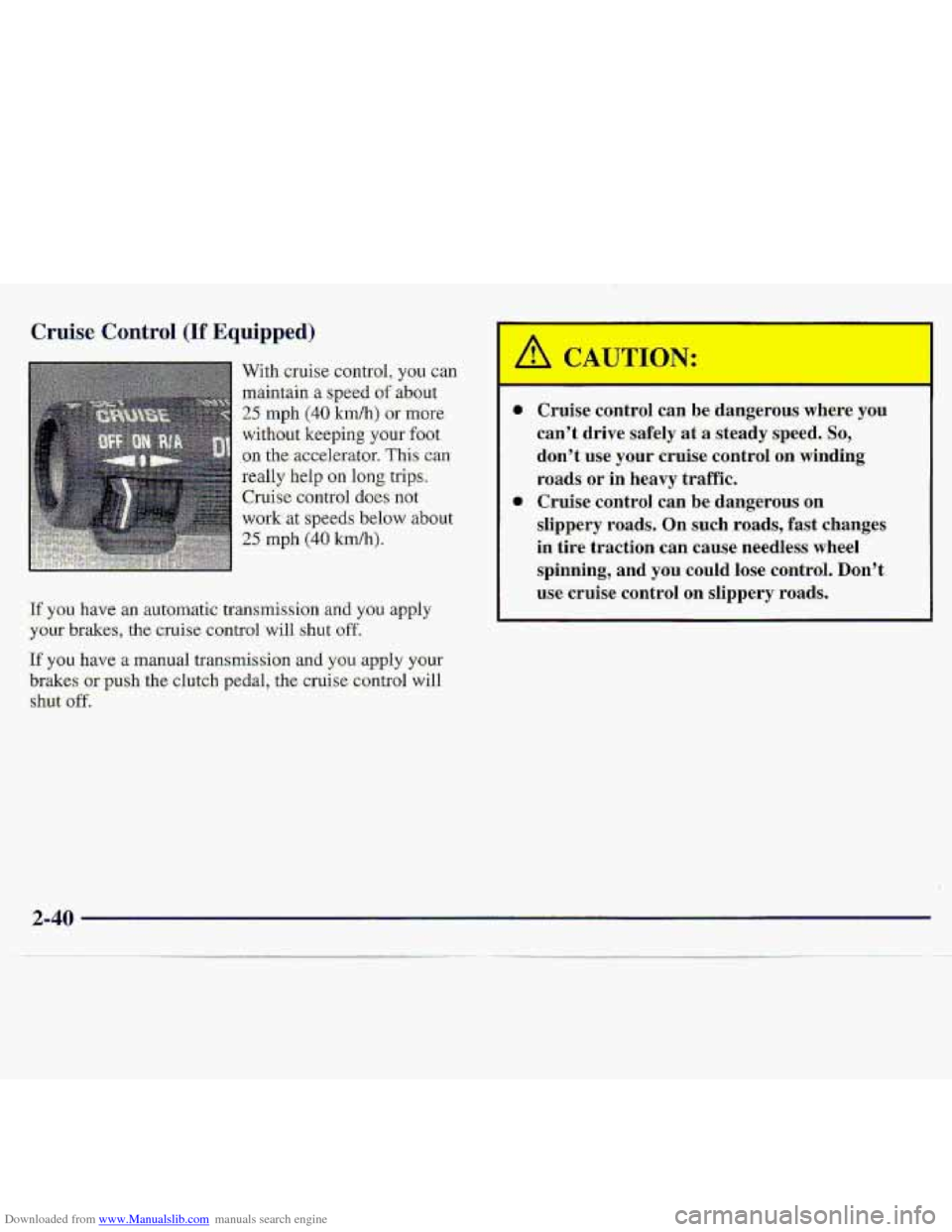
Downloaded from www.Manualslib.com manuals search engine Cruise Control (If Equipped)
-With cruise control, you can
.maintain a speed of about
25 mph (40 km/h) or more
without keeping your foot
on the-accelerator. This can
really help on long trips.
Cruise control does not
work-at speeds belo-w about
25 mph (4.0 kdh).
If you have an automatic transmission and y.0~ apply
your brakes, the cruise control will shut off.
:If you have a manual transmission and you apply your
brakes
or push the clutch pedal, the cruise control will
shut off:
@ Cruise control can be dangerous where you
can’t drive safely aka steady
speed. So,
don’t use your cruise control on winding
roads or in heavy traffic.
slippery
roads. On such roads, fast changes
in
tire traction can cause needless. wheel
spinning, and you could lose control. Don’t
use cruise control on slippery
roads.
a Cruise control can be dangerous on
2-40
Page 145 of 402
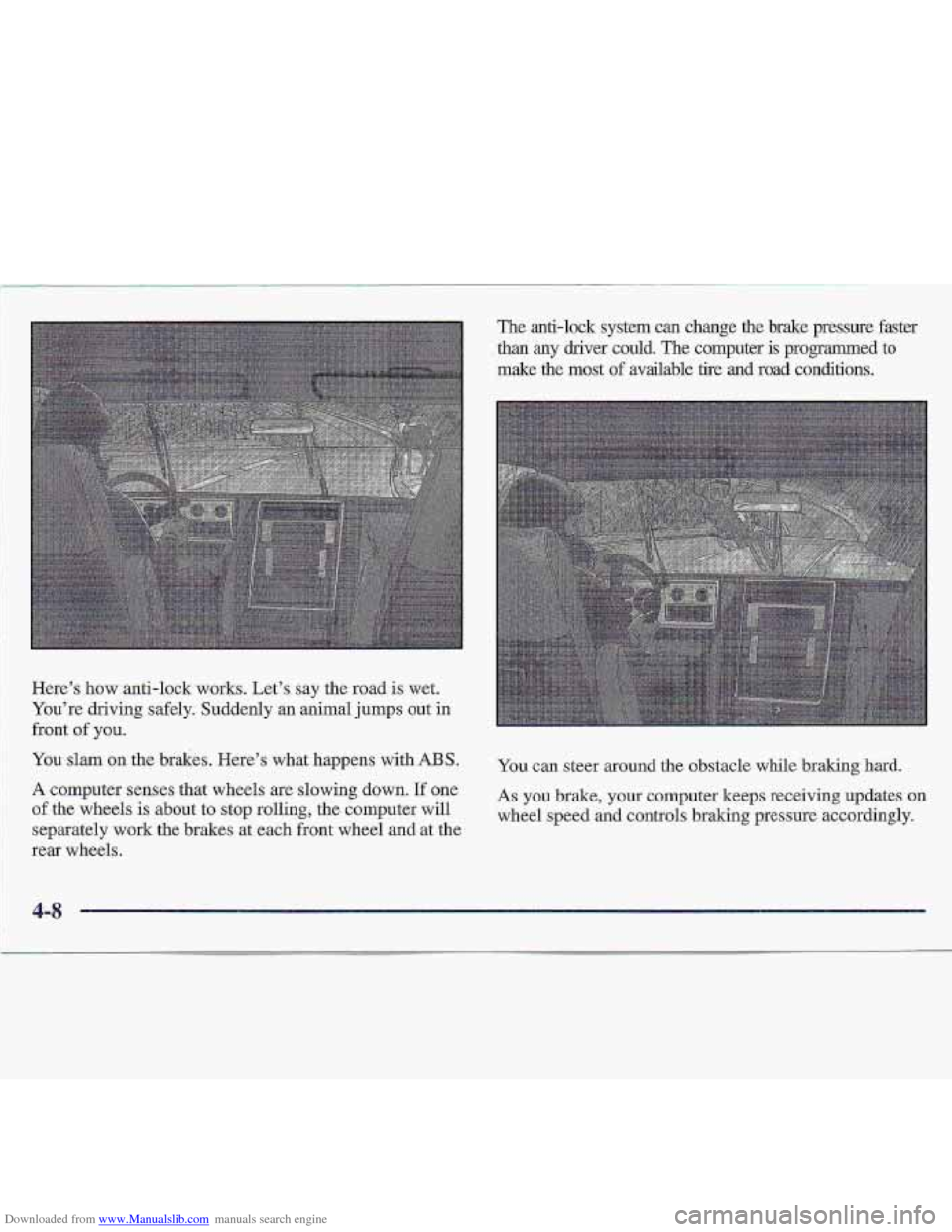
Downloaded from www.Manualslib.com manuals search engine Here’s how anti-lock works. Let’s. say the road is wet.
You’re driving safely; Suddenly-an animal jumps out
in
front of you.
1 You slam on the brakes, Here’s what happens with ABS.
A computer senses that wheels are slowing down. If one
of the wheels is about to stop rolling, the computer will
separately work the brakes at each front wheel and at the
~ rear wheels.
The anti-lock system em change the brake p~essure faster
than any driver could. ?%e computer is programmed to
make the most of available tire and road tronditions.
You cansteer around the obstacle while braking hard.
As you brake, your computer keeps receiving updates- on
wheel speed and controls braking pressure accordingly.
Page 146 of 402
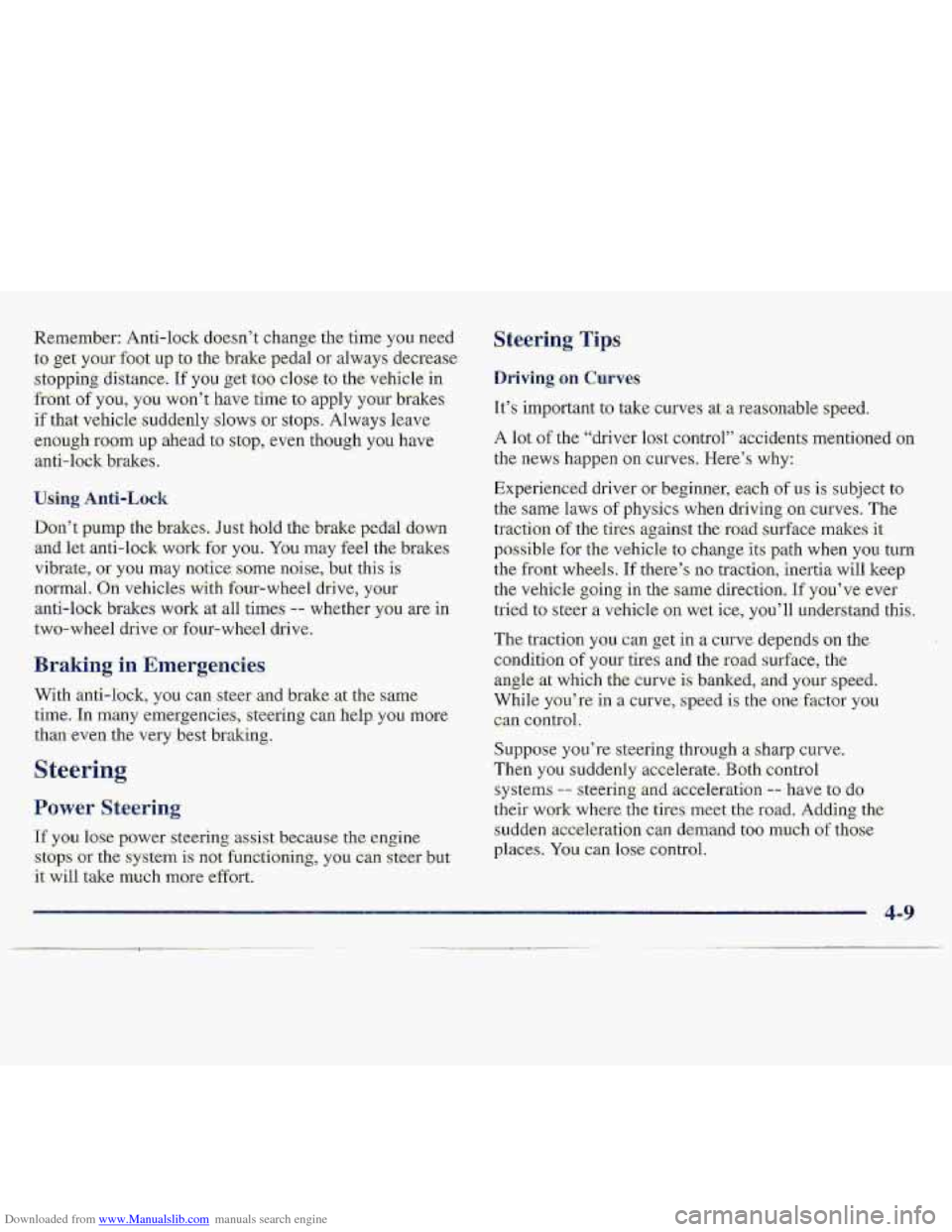
Downloaded from www.Manualslib.com manuals search engine Remember: Anti-lock dsesn’t change tbc- -time y.ou :need
:to get yo.ur fo~t up to .the brake ped,ai or always decrease
stopping
diskan&. If.you get-to6 cl~,se to thcvehicle in
front of YOU; you won’t have time to apply your brzikes
If.th:at vehicle suddelily .slows or siop-s. Always i-eave
e.nough mom up ahead to si.op, even though you have
anti-lockrbpkes.
U.s,ing.Anti.-LthA
Don’t pump the’bisakes. Just hdd the brake pedzl down
and let anti-lock wark..fox you. You ‘may feel the brake.$
vibrate., or you-may notice som-e noise, but this is-
::normal. Ofi vehicles Mth-four-wheel drive, your
;anti-lockbrakes work at all times- -- whether ,you are in
two-wheel driveor fuur-wheel:&.ive.
Braking in Emergencies,
With m-ti-lock, you can steer and brake at thc same
.time-. In many emergencies., st.eering can kip, you more
than even the very $est braking.
Power Steering
If you lose p~wer steeringatssist because the e.ngine
stop;s or the system is not fiw.dt?orriag, you can ste.er .but
it will take much more effort.
Steering Tips
It’s important to take c.urv.es at a reasonable sp-eed.
A lot of the “drivet lo‘st ci3ntml”‘accidents meritionedl ~li
the slews happen on curves. Here’-s why
Page 150 of 402
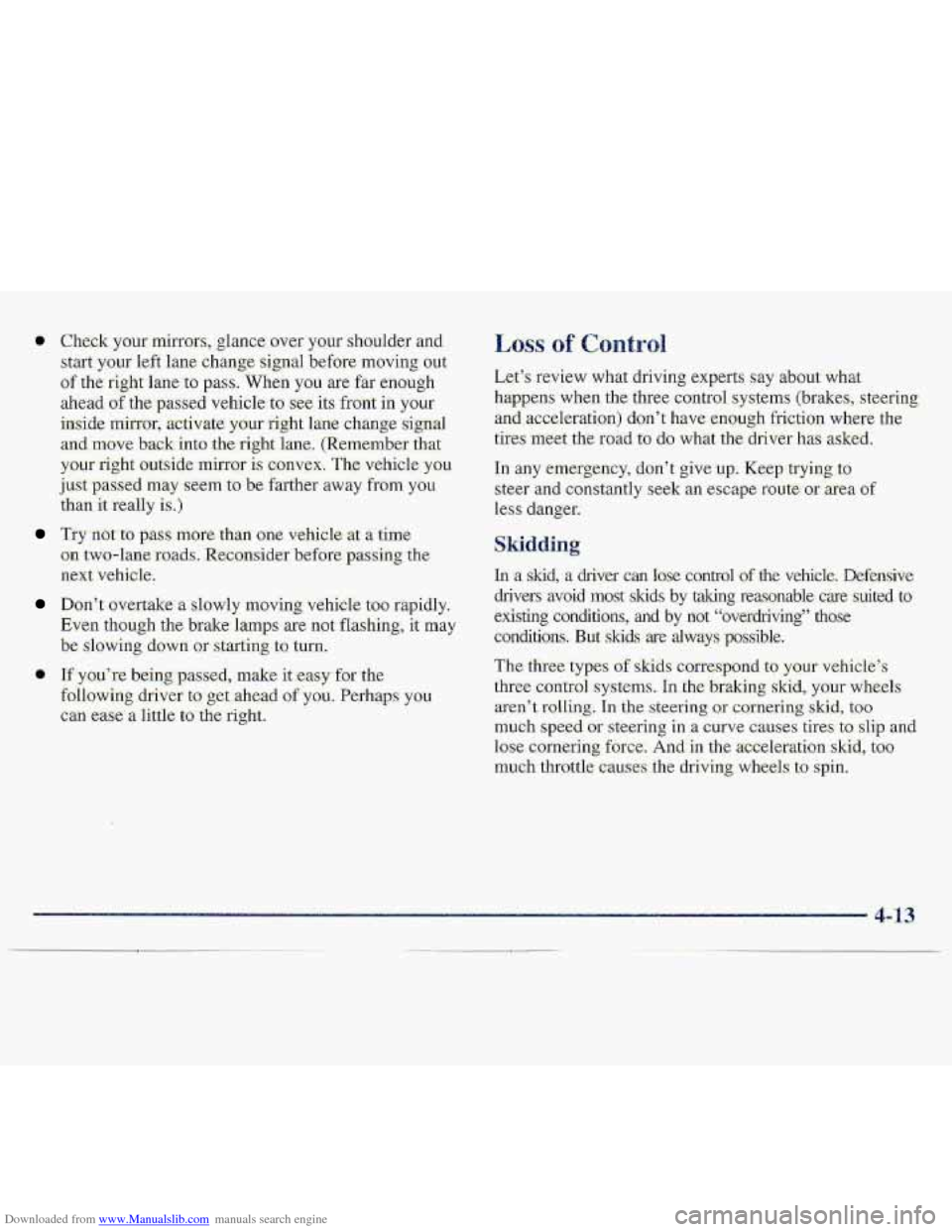
Downloaded from www.Manualslib.com manuals search engine * Check your mirrors, glance over your shoulder and.
start your left lane change
signal before-moving out
of the right.lane to pass. When you are far enough
ahead
of the passe.d vehicle to see its front in your
inside -01, activate your right lane change sigmd
and-move back into the.
ri,ght lane. (Remember that
your-right outside ,mirror is convex. The vehicle you
juslpassed may
seem to be farther away from y6u
than it really is.)
Tfy not co p.ass mufe ,than one vehicle ,at a time
on two-lane’roads. Reconsider before passing the
next vehicle.
D.on’:t overtake-.a slowly moving vehi-de too rapidly.
Even though
the brake -1amp.s are not flashing, it m.a.y
be slowing down or starting to, turn.
Qi If+ you’re being .passed, make it easy- for the
fallowing driver to
get..ahead .of you. Perh,aps you
can ease.&
little to the right.
Let’s review what driving expmts s-ay about what
happens when the thre.e
con.trol systems- (brakes., steering,
and,acceleration) don’t
have enough friction where the
tifes ”meet the road to do what the drivt?r has asked..
In any emergency, don’t give up Keep trying to
steer and constantly seek
an escape route-or aea of
less danger.
In a. skid, a driver cn lose control of .the vehicle, Defensive
drivers .avoid
most skids by taking reasonable care suited t9
existing conditiolrs, and by not “overdriving” those
conditions.. But- ,&ids
are always -pa.ssible.
The three typcis of skids correspond to your vehicle’s
three
c’0ntro1 syst,erns. In. the. brakifig skid, y0.m whe.eIs
aren’t rpl.ling. Ln the steering or- cornering skid, too
much speed or steering in a curve causes tires: to slip and
lase cornehg, foxce,. And. in the acceleration skid, too
much throttle causes the driving wheels- to spin.
4-13
Page 164 of 402
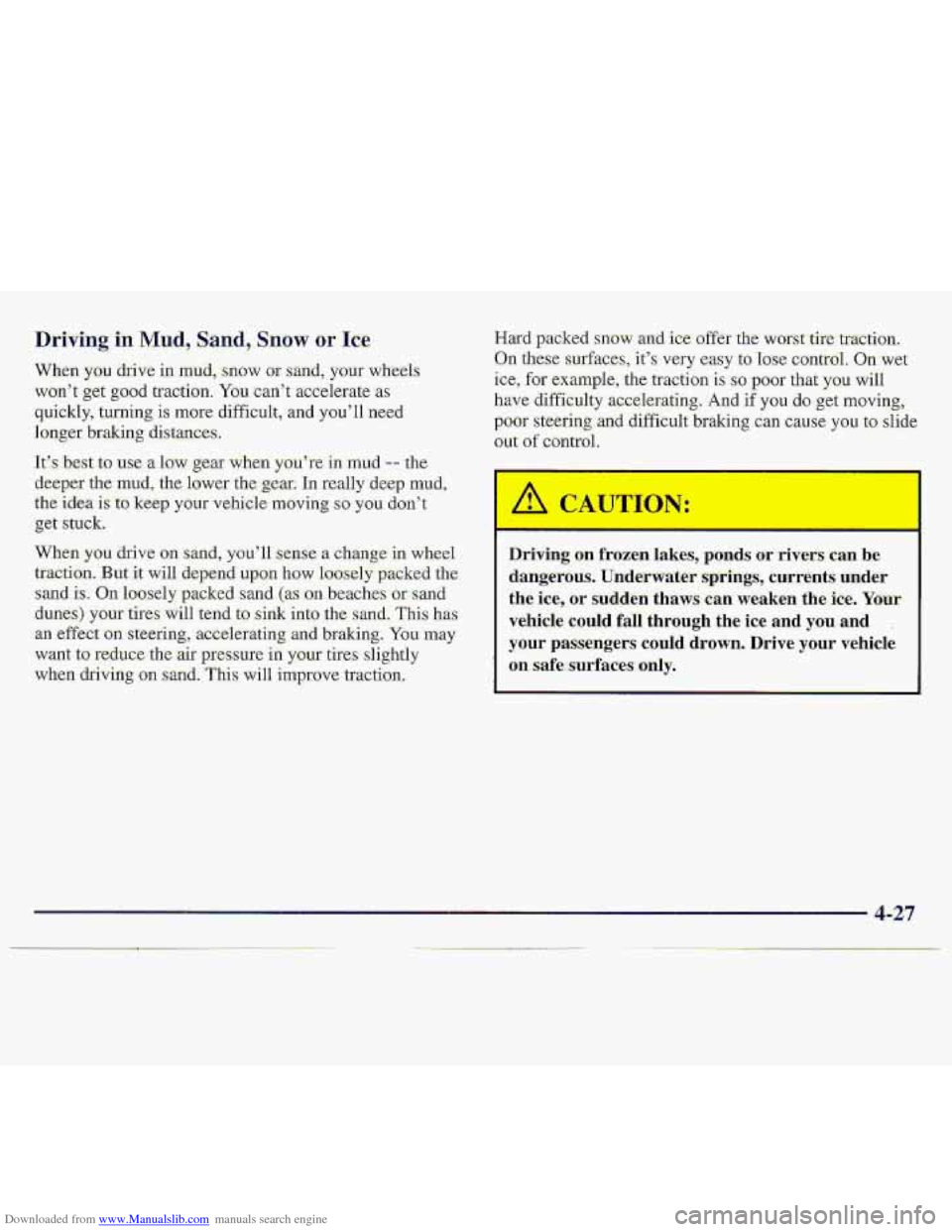
Downloaded from www.Manualslib.com manuals search engine Driving in Mnd, Sand, Snow or Ice
When you dxive in mu.d, snow or sarsd, your wheels
won’t get good traction. You can’t accelemte as
quickly, turning i.s more dif€icult, and you’ll need
longer braking distances.
It’s best .to use a low..gear when you’re in mud -- the
,deeper the mud, the lower the gear: In really ,deep mud,
$he idea is to keep your vehicle- moving s.0 you don’t
.!get stuck.
When
you drive on sand, yo-u’ll sensg a change- in wheel
traction, But St will &pmd upon how looseiypacked the
,sand is. On loosely packed sand (as on. beaches or sand
dunes)
your tires will tend to sink into the sand. This has
an effect on steering, accelefating and braking. You may
,w.ant to reduce the air pressure in your tires slightly
when driving on :sand. ‘This. will improve traction,
Hard packed mow ;sad ice. oEer the wofWtire’tractioa.
On thes~e s-Urfac.e.s, it’s very easy to lase c.on!Td, On wet
ice, for example, the traction i.s so paor that you will
h,ave diffic-ulty
accelerating, And if you d:o gkt movi.ng,
poor sleeting and difficult braking- can cause you to slide
out of control.
Driving on frozen lakes, ponds or rivers can be
dangerom. Undewater sprirmgs, currents under
the ice, or
sudden thaws can weaken the ice, Your
vehicle could fall through the ice and you and ,
your passengers could drown. Drive your vehicle
on -safe-surfaces only.
Page 220 of 402
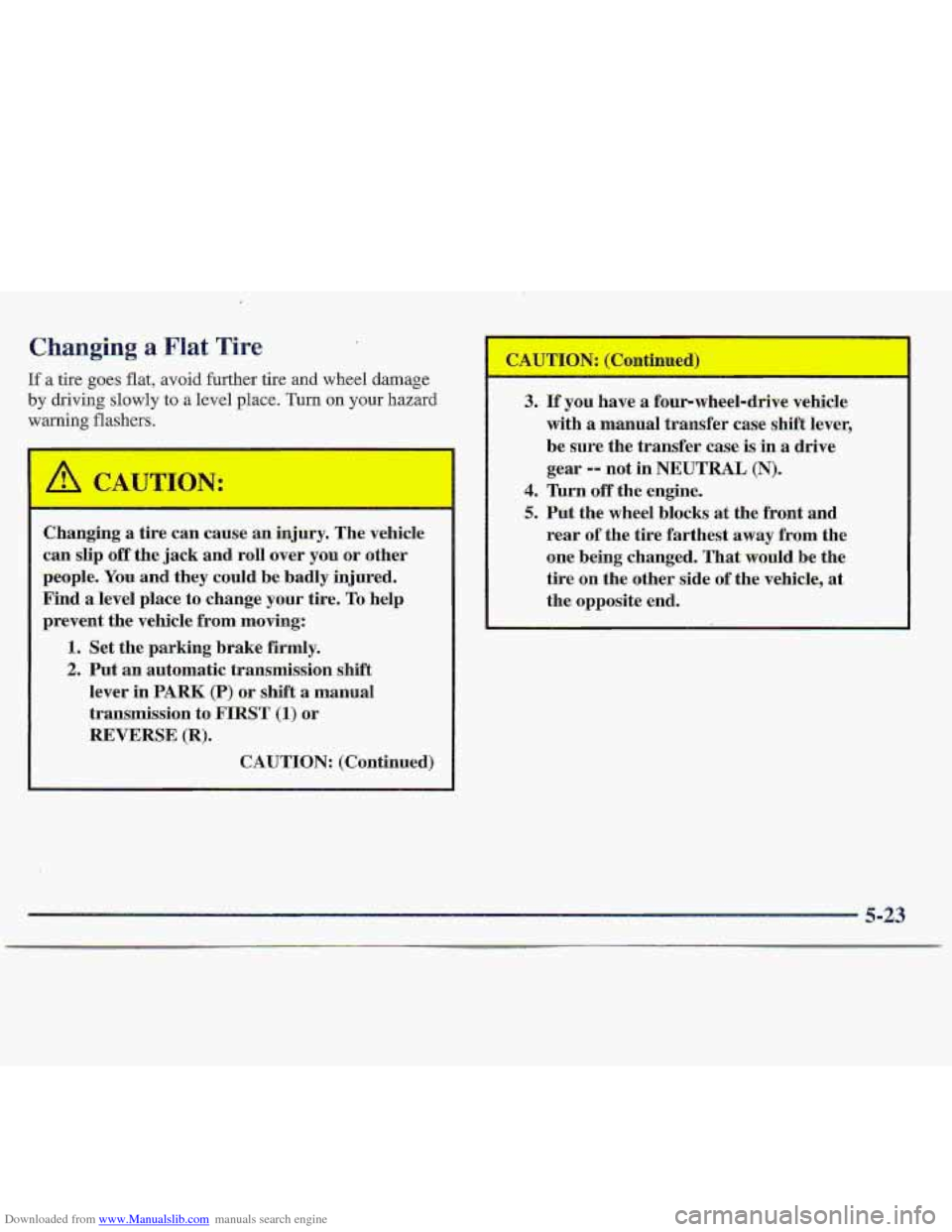
Downloaded from www.Manualslib.com manuals search engine If a tire goes flat, avoid further tire and wheel damage
by driving slowly to a level place. Turn on your hazard
warning flashers.
Changing a tire can cause an injury. The vehicle
can slip off the jack and roll over
you or other
people.
You and they could be badly injured.
Find
a level place to change your tire. To help
prevent the vehicle from moving:
I. Set the parking brake firmly.
2. Put an automatic transmission shift
lever in
PARK (PI or shift a manual
transmission to FIRST (1) or
REVERSE (R).
CAUTION: (Continued)
3. If you have a four-wheel-drive vehicle
with
a manual transfer case shift lever,
be sure the transfer case is in
a drive
gear
-- not in NEUTRAL (N).
4. Turn off the engine.
5. Put the wheel blocks at the front and
rear
of the tire farthest away from the
one being changed. That would be the
tire on the other side
of the vehicle, at
the opposite end.
Page 227 of 402
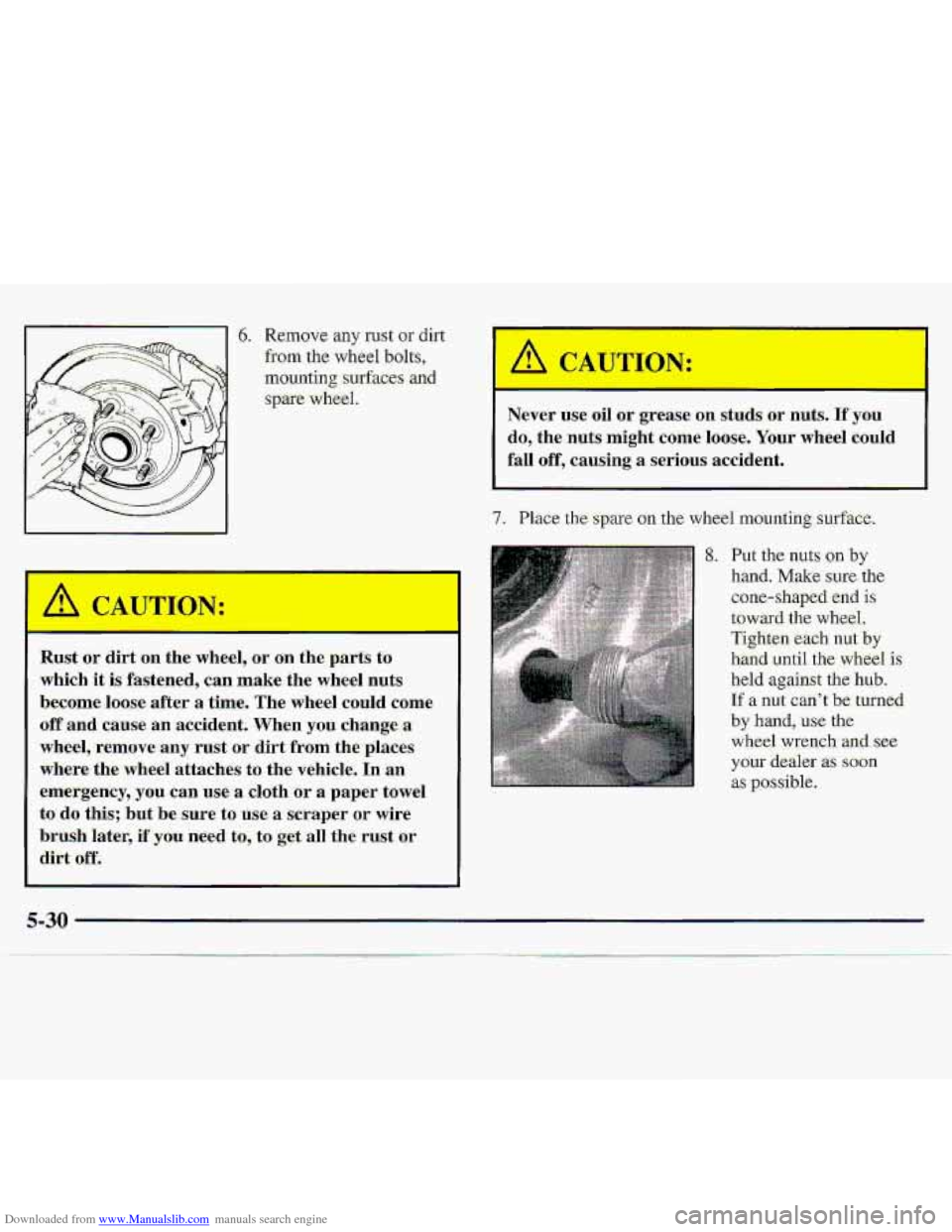
Downloaded from www.Manualslib.com manuals search engine b. Remove any rust or dirt
from the wheel bolts,
mounting surfaces and
spare wheel.
Rust or dirt on the wheel, or on the parts to
which
it is fastened, can make the wheel nuts
become loose after
a the. Th-e wheel could come
off.and cause an accident. When you change a
wheel,-remove-.any rust or dirt from the places
where the wheel attach.es
to the vehicle. In an
emergency,
you can use a cloth or a paper towel
todo this; but be sure to use a scraper or wire
brush rater, if .you need to, to get all the rust or
dirt off.
Never use oil or grease on studs or nuts.. If you
do, the nuts might come loose. Your wheel could
fall off, causing a serious accident.
7. Place the spare on the wheel mounting- surface.
8. Put the nuts on by
hand. Make sure. the
c.one-shapd end is
toward the wheel.
Tighten each nut by
hand untiI the- wheeI is
held against the hub.
If a nut can’t bel turned
by hand,. us.e the
wheel wrench.
and see
your deal.er as soon
as possible.
5-30
Page 284 of 402
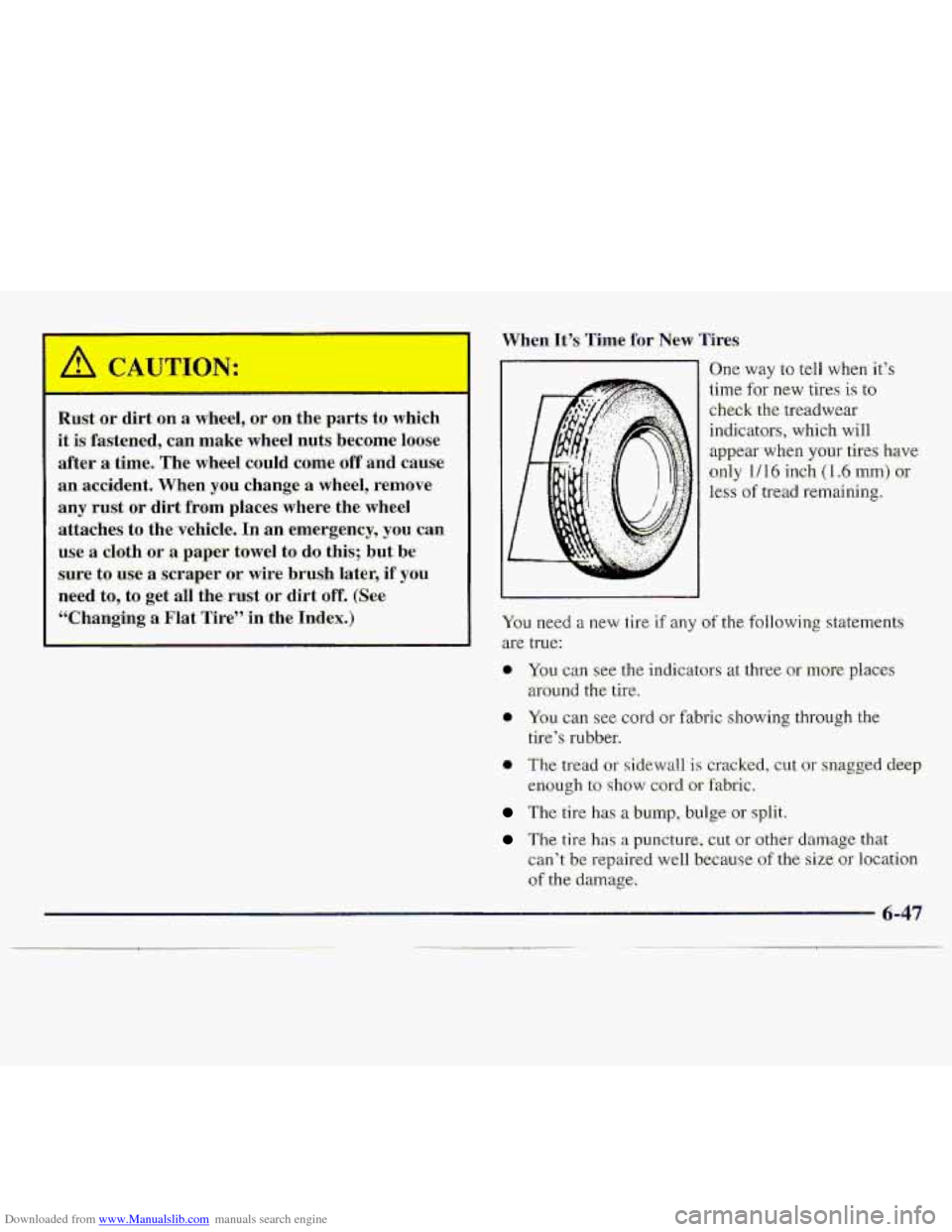
Downloaded from www.Manualslib.com manuals search engine When, U’s Time for Nk-W Tires
Rust-or dirt on a wheel,. or on the parts to which
it is fastened, can make wheel nuts bec:ome lo-ose
a-ftep a. time. The wheel coukd come off and cause:
an accident. When you change a wheel, remove
any .rust or dirt from places where the wheel
attaches
to the vehicle. In an emwgency, you can
use a cloth or a paper: towel to do this; but be
sgre to use a scraper or wim brush later, if you
need to, to get all the rust or dirt off. (See
“Changing a Flat Tire” in .the Index.)
One way to tell when it’s
time
for new tires is to
check the treadwear
indicators, which wil’l
appear when yo-ur tires have
only l/ 16 inch (1.6 mnm) or
less of tread remaining.
10 You can see the indicators at three 01: mn1-e places
around. thetire-.
a You can see cord .or f’abric showing through the
tire’s rubber.
The tread or sidewall is cracked, cut or snagged deep
enou.gh to show cord-or fabric.
The tire has a bump, bulge or split.
The tire hn.s a puncture, cut or other damage that
can’t be repaired well because of the size 01: :location
of the damage.